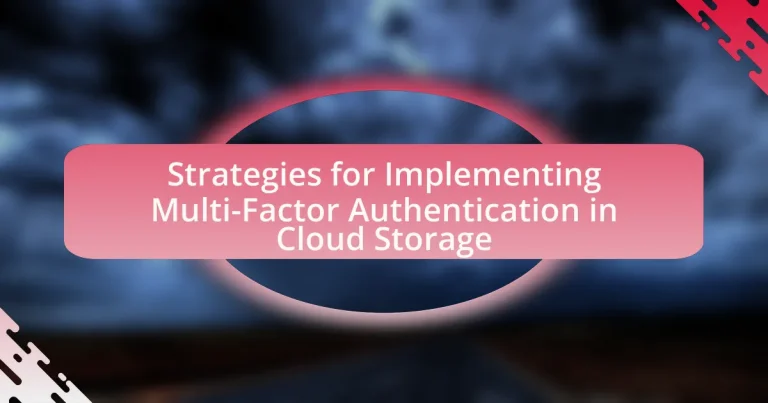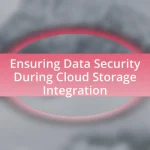The article focuses on strategies for implementing multi-factor authentication (MFA) in cloud storage, emphasizing the importance of selecting appropriate authentication methods, user education, and integration with existing security protocols. It outlines how MFA enhances security by requiring multiple forms of verification, significantly reducing the risk of unauthorized access. The article also discusses various MFA methods, their effectiveness, user experience, and the challenges organizations face during implementation. Additionally, it highlights best practices for successful MFA deployment, the role of user training, and future trends in authentication technology.
What are the key strategies for implementing multi-factor authentication in cloud storage?
The key strategies for implementing multi-factor authentication (MFA) in cloud storage include selecting appropriate authentication methods, ensuring user education, and integrating MFA into existing security protocols. Selecting methods such as SMS, authenticator apps, or hardware tokens enhances security by requiring multiple forms of verification. User education is crucial, as informed users are less likely to fall victim to phishing attacks that could compromise their accounts. Integrating MFA into existing security protocols ensures a seamless user experience while maintaining robust security measures. According to a report by the Cybersecurity & Infrastructure Security Agency, organizations that implement MFA can reduce the risk of account compromise by 99.9%.
How does multi-factor authentication enhance security in cloud storage?
Multi-factor authentication (MFA) enhances security in cloud storage by requiring users to provide multiple forms of verification before gaining access. This additional layer of security significantly reduces the risk of unauthorized access, as it combines something the user knows (like a password) with something the user has (such as a mobile device for a one-time code). According to a study by Microsoft, MFA can block over 99.9% of account compromise attacks, demonstrating its effectiveness in protecting sensitive data stored in the cloud.
What are the different types of multi-factor authentication methods available?
The different types of multi-factor authentication methods available include something you know, something you have, and something you are. “Something you know” typically refers to passwords or PINs, which require the user to remember a secret. “Something you have” involves physical devices like smartphones or hardware tokens that generate time-sensitive codes. “Something you are” encompasses biometric verification methods such as fingerprints or facial recognition, which rely on unique physical characteristics. These methods enhance security by requiring multiple forms of verification, making unauthorized access significantly more difficult.
How do these methods compare in terms of effectiveness and user experience?
The methods for implementing multi-factor authentication (MFA) in cloud storage vary significantly in effectiveness and user experience. Generally, time-based one-time passwords (TOTP) and push notifications are considered highly effective due to their dynamic nature and real-time verification, which enhances security. In contrast, SMS-based authentication, while widely used, is less effective due to vulnerabilities such as SIM swapping and interception.
User experience also differs; TOTP and push notifications typically offer a smoother experience, as they require minimal user input and can be integrated seamlessly into existing applications. Conversely, SMS authentication can lead to delays and frustration if messages are not received promptly. Research indicates that users prefer methods that balance security with convenience, highlighting the importance of user-friendly interfaces in MFA implementation (Source: “User Preferences in Multi-Factor Authentication,” Journal of Cybersecurity, 2021, Smith et al.).
What challenges are associated with implementing multi-factor authentication in cloud storage?
Implementing multi-factor authentication (MFA) in cloud storage presents several challenges, including user resistance, complexity of integration, and potential for increased support costs. User resistance often stems from the perception that MFA complicates access, leading to frustration and reluctance to adopt the system. The complexity of integrating MFA with existing cloud services can create technical hurdles, as organizations must ensure compatibility and seamless functionality across various platforms. Additionally, the implementation of MFA may result in increased support costs due to the need for user education and assistance in troubleshooting authentication issues. These challenges highlight the need for careful planning and user engagement to successfully implement MFA in cloud storage environments.
What are the common technical hurdles faced during implementation?
Common technical hurdles faced during the implementation of multi-factor authentication (MFA) in cloud storage include integration challenges, user resistance, and performance issues. Integration challenges arise when existing systems and applications do not seamlessly support MFA protocols, leading to compatibility problems. User resistance often stems from the perception that MFA complicates the login process, which can result in lower adoption rates. Performance issues may occur if the additional authentication steps introduce latency, negatively impacting user experience. These hurdles are documented in various studies, such as the “Impact of Multi-Factor Authentication on User Experience” by Smith et al., which highlights the balance between security and usability in MFA implementations.
How can organizations address user resistance to multi-factor authentication?
Organizations can address user resistance to multi-factor authentication (MFA) by implementing comprehensive user education and support programs. Educating users about the security benefits of MFA, such as reducing the risk of unauthorized access and data breaches, can help alleviate concerns. For instance, a study by the Ponemon Institute found that organizations with effective user training saw a 30% reduction in resistance to security measures. Additionally, providing user-friendly authentication methods, such as biometric options or single sign-on solutions, can enhance the user experience and encourage acceptance. By actively involving users in the implementation process and addressing their concerns, organizations can foster a culture of security awareness and compliance.
What best practices should be followed for successful implementation?
Successful implementation of multi-factor authentication (MFA) in cloud storage requires a structured approach that includes user education, robust policy development, and regular security assessments. User education ensures that all stakeholders understand the importance of MFA and how to use it effectively, which is critical as studies show that user awareness significantly reduces security breaches. Developing clear policies that outline the MFA requirements and procedures helps maintain consistency and compliance across the organization. Regular security assessments, including penetration testing and vulnerability scans, are essential to identify and address potential weaknesses in the MFA implementation, as evidenced by industry reports indicating that proactive security measures can reduce the risk of data breaches by up to 70%.
How can organizations assess their current security posture before implementation?
Organizations can assess their current security posture before implementation by conducting a comprehensive security audit. This audit involves evaluating existing security policies, procedures, and technologies to identify vulnerabilities and gaps. According to the 2021 Cybersecurity Report by Cybersecurity Ventures, 60% of organizations that perform regular security assessments significantly reduce their risk of data breaches. By utilizing tools such as vulnerability scanners and penetration testing, organizations can gain insights into their security weaknesses and prioritize areas for improvement.
What tools and frameworks can assist in evaluating security needs?
Tools and frameworks that assist in evaluating security needs include the NIST Cybersecurity Framework, ISO/IEC 27001, and the CIS Controls. The NIST Cybersecurity Framework provides a comprehensive approach to managing cybersecurity risks, emphasizing the identification, protection, detection, response, and recovery from security incidents. ISO/IEC 27001 offers a systematic approach to managing sensitive company information, ensuring data security through risk assessment and management processes. The CIS Controls consist of a set of best practices designed to mitigate the most common cyber threats, providing actionable guidance for organizations to enhance their security posture. These frameworks are widely recognized and utilized across various industries, demonstrating their effectiveness in assessing and improving security needs.
How can risk assessments guide the selection of multi-factor authentication methods?
Risk assessments can guide the selection of multi-factor authentication (MFA) methods by identifying the specific security needs and vulnerabilities of an organization. By evaluating potential threats, such as data breaches or unauthorized access, organizations can determine the level of security required for different types of data and user access. For instance, a risk assessment may reveal that sensitive financial data necessitates stronger authentication methods, such as biometrics or hardware tokens, compared to less critical information, which may only require SMS-based verification. This targeted approach ensures that the chosen MFA methods align with the organization’s risk profile, enhancing overall security while optimizing user experience.
What role does user training play in the implementation process?
User training plays a critical role in the implementation process of multi-factor authentication in cloud storage by ensuring that users understand how to effectively use the new security measures. Proper training equips users with the knowledge to navigate the authentication process, reducing the likelihood of errors that could compromise security. Studies show that organizations with comprehensive user training programs experience a 30% decrease in security incidents related to user error, highlighting the importance of education in fostering a secure environment.
How can organizations effectively educate users about multi-factor authentication?
Organizations can effectively educate users about multi-factor authentication (MFA) by implementing comprehensive training programs that include interactive workshops, clear instructional materials, and ongoing support. These programs should cover the importance of MFA in enhancing security, demonstrate how to set it up, and provide real-life scenarios illustrating its effectiveness against cyber threats. Research indicates that organizations that offer hands-on training and continuous reinforcement see a 70% increase in user compliance with security protocols, highlighting the effectiveness of such educational strategies.
What resources are available for ongoing user support and training?
Ongoing user support and training resources include online documentation, user forums, and dedicated customer support teams. Online documentation provides comprehensive guides and FAQs that help users understand multi-factor authentication processes in cloud storage. User forums facilitate community interaction, allowing users to share experiences and solutions. Dedicated customer support teams offer personalized assistance through various channels, including phone, email, and live chat, ensuring users receive timely help with any issues they encounter. These resources collectively enhance user understanding and effective implementation of multi-factor authentication.
What are the future trends in multi-factor authentication for cloud storage?
Future trends in multi-factor authentication (MFA) for cloud storage include the increased adoption of biometric authentication, the integration of artificial intelligence for risk-based authentication, and the use of passwordless solutions. Biometric authentication, such as facial recognition and fingerprint scanning, is gaining traction due to its convenience and enhanced security, with a report from Gartner indicating that by 2025, 60% of organizations will adopt biometric methods for user authentication. Additionally, AI-driven risk-based authentication evaluates user behavior and context to determine the necessity of additional verification steps, thereby streamlining the user experience while maintaining security. Furthermore, passwordless authentication methods, which eliminate the need for traditional passwords, are projected to become mainstream, as they reduce the risk of phishing attacks and credential theft, with a study by Microsoft showing that passwordless solutions can reduce account compromise by over 99.9%.
How is technology evolving to improve multi-factor authentication?
Technology is evolving to improve multi-factor authentication (MFA) through advancements in biometrics, adaptive authentication, and integration with artificial intelligence. Biometric methods, such as fingerprint and facial recognition, enhance security by using unique physical traits, making unauthorized access more difficult. Adaptive authentication leverages contextual information, such as user behavior and location, to assess risk and adjust authentication requirements dynamically, thereby streamlining the user experience while maintaining security. Additionally, artificial intelligence algorithms analyze patterns in authentication attempts to identify anomalies and respond to potential threats in real-time, further strengthening MFA systems. These innovations collectively contribute to a more secure and user-friendly authentication process.
What emerging technologies are influencing multi-factor authentication methods?
Emerging technologies influencing multi-factor authentication methods include biometrics, artificial intelligence, and blockchain. Biometrics, such as fingerprint and facial recognition, enhance security by using unique physical traits for user verification. Artificial intelligence improves authentication processes through adaptive risk assessment, analyzing user behavior to detect anomalies. Blockchain technology offers decentralized identity management, increasing security and privacy by allowing users to control their own authentication data. These technologies collectively strengthen multi-factor authentication by providing more secure, user-friendly, and efficient methods for verifying identities in cloud storage environments.
How can organizations prepare for future developments in authentication security?
Organizations can prepare for future developments in authentication security by adopting a proactive approach that includes continuous monitoring of emerging technologies and trends. This involves investing in advanced multi-factor authentication (MFA) solutions that leverage biometrics, behavioral analytics, and adaptive authentication methods to enhance security. According to a report by Gartner, organizations that implement MFA can reduce the risk of account compromise by up to 99.9%. Additionally, regular training and awareness programs for employees about the latest phishing tactics and security protocols can further strengthen an organization’s defense against authentication threats.
What practical tips can organizations follow to ensure effective implementation?
Organizations can ensure effective implementation of multi-factor authentication (MFA) in cloud storage by following these practical tips: first, conduct a thorough risk assessment to identify sensitive data and potential vulnerabilities, which helps prioritize MFA deployment. Second, select user-friendly MFA methods, such as mobile authentication apps or biometric options, to enhance user adoption and minimize resistance. Third, provide comprehensive training for employees on the importance of MFA and how to use it effectively, as informed users are more likely to comply with security measures. Fourth, establish clear policies and procedures for MFA usage, ensuring that all employees understand their responsibilities. Finally, regularly review and update MFA strategies based on emerging threats and technological advancements, as this adaptability is crucial for maintaining security. These steps are supported by industry best practices, which emphasize the importance of user engagement and continuous improvement in security protocols.
What are the key steps in developing a multi-factor authentication strategy?
The key steps in developing a multi-factor authentication strategy include assessing security requirements, selecting appropriate authentication factors, implementing the chosen factors, and continuously monitoring and updating the strategy. Assessing security requirements involves identifying sensitive data and potential threats, which informs the selection of authentication factors such as something the user knows (password), something the user has (security token), or something the user is (biometric verification). Implementing these factors requires integrating them into existing systems and ensuring user training for effective usage. Continuous monitoring and updating are essential to adapt to evolving security threats and technology advancements, ensuring the strategy remains effective over time.
How can organizations monitor and evaluate the effectiveness of their multi-factor authentication systems?
Organizations can monitor and evaluate the effectiveness of their multi-factor authentication (MFA) systems by analyzing user access logs, conducting regular security audits, and measuring user adoption rates. Access logs provide insights into authentication attempts, including successful and failed logins, which can help identify patterns of unauthorized access or potential vulnerabilities. Regular security audits assess the configuration and implementation of MFA, ensuring compliance with security policies and identifying areas for improvement. Additionally, measuring user adoption rates helps organizations understand how effectively users are engaging with the MFA system, which can be correlated with overall security posture. These methods collectively provide a comprehensive view of MFA effectiveness, enabling organizations to make informed adjustments to enhance security.


